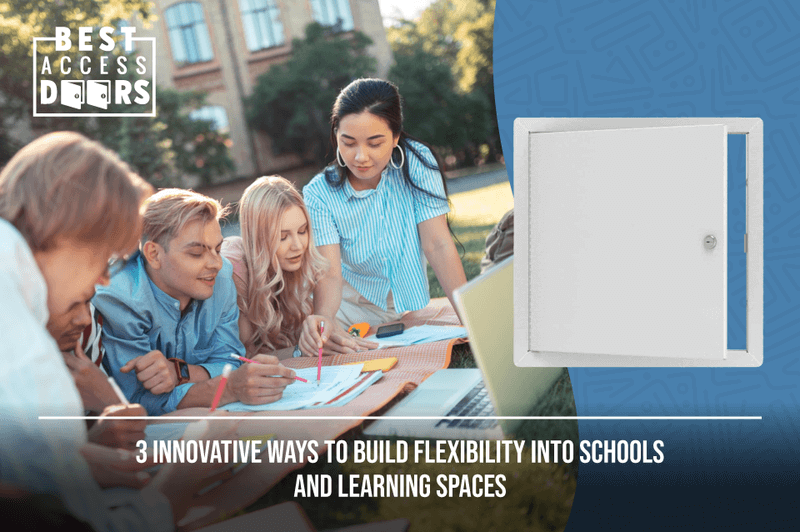3 Innovative Ways to Build Flexibility into Schools and Learning Spaces
Posted by Best Access Doors on 17th Apr 2024
Today's schools need to keep up with how fast everything changes, including how we teach and learn. That's where flexible learning spaces come in. They are designed to adjust easily to fit different teaching methods and learning needs. Making these spaces work well requires clever ideas and smart design choices.
In this article, we'll explain how schools can become more adaptable and ready for whatever learning looks like tomorrow. We'll explore the nuts and bolts of modular design, why technology plays a crucial role, and how even outdoor spaces can contribute to learning in new and exciting ways. It’s all about making spaces that aren’t just functional but also engaging and secure for everyone who uses them.
1. Modular and Adaptable Design
Modular design is all about making spaces that can change as needed. Instead of classrooms that always look the same, modular spaces can be rearranged to fit new ideas or activities.
Features
Imagine walls that move, tables and chairs on wheels, and spaces that can grow or shrink. That’s what modular design brings to the table. It allows a room to switch from a place for group projects to a quiet study area without much hassle. This flexibility means teachers can set up their classrooms to best fit their lessons for the day.
Benefits
The biggest plus of modular design? It keeps everyone engaged. When students can move around and work together in a space that fits the activity, they're more likely to pay attention and get involved. It also means all students can find a spot that works for them, no matter their needs. And for teachers, it’s a chance to shake things up and try new ways of teaching. In short, modular and adaptable design helps make schools more lively, inclusive, and ready for the future.
2. Technology-Enhanced Learning Environments
Technology is changing how we teach and learn, making it more interactive and accessible. Smartboards, tablets, and online resources let students learn in ways that work best for them. But it's not just about the gadgets; it's about creating spaces where technology supports learning in flexible, innovative ways.
Smart Classrooms: More Than Just Tech
A smart classroom isn’t just filled with tech; it’s designed around it. That means Wi-Fi that covers every corner, plenty of power outlets, and furniture that can move as needed to use technology in different ways. It's about making it easy for everyone to share ideas digitally, whether they're in the room or joining from home.
Securing Our Tech Spaces
As we bring more technology into schools, keeping it safe is crucial. This is where something like the BA-MDS Medium Security Access Door comes in. It’s designed to secure areas where we can keep tech gear. Its build and lock system means only the right people can access the equipment. This kind of security is essential for creating flexible learning environments that are not only innovative but also safe and reliable.
3. Outdoor and Nature-Inspired Learning Spaces
More schools are seeing the value of stepping outside the traditional classroom. Outdoor learning spaces can be anything from gardens to flexible seating areas outside. They offer fresh air and a change of scenery, which can help students feel more relaxed and ready to learn.
Designing with Flexibility in Mind
Creating outdoor learning spaces means thinking about how they can change and grow. It's about choosing materials and designs that last and can be moved or adjusted as needed. This might mean movable benches, planters on wheels, or tech that can come outside when the weather’s good.
Why Nature Matters
Being close to nature, even in small ways, can boost learning and well-being. Studies show that when students learn in natural settings, they can focus better and are more engaged. Plus, using outdoor spaces for learning means schools have more room to spread out and try different activities, making education a breath of fresh air—literally.
Creating flexible learning spaces is about more than just moving walls or adding the latest tech. It's about designing environments that inspire and adapt to the ever-changing landscape of education. From modular classrooms that shift with the day's needs to the natural calm of outdoor learning, each element plays a vital role in shaping dynamic and inclusive educational experiences.
Let's embrace these innovative ways to build flexibility in schools and learning spaces. In doing so, we not only prepare our spaces for the future of education but also empower our students and teachers to thrive in an ever-evolving world. Here's to creating learning environments that are not just built for today but ready for whatever tomorrow brings.
Trusted Access Solutions? Connect with BEST!
At Best Access Doors, we understand the importance of creating secure and adaptable educational environments. As the USA's largest access solution provider, our team is here to support you in finding the perfect solutions for your flexible learning spaces.
Whether you're planning to install the latest in security access doors or seeking advice on the best options for your project, we're ready to answer your toughest questions. Visit our Blog page for more insights on relevant construction topics or call us at (800) 483-0823to learn how we can assist with your next project.
Share our story - get our 2024 Catalog for FREE!

